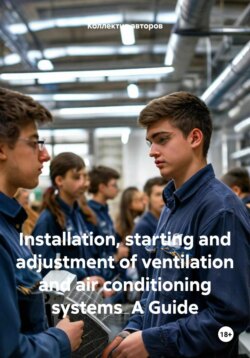Читать книгу Installation, starting and adjustment of ventilation and air conditioning systems A Guide - - Страница 3
Chapter II. Purpose and arrangement of ventilation systems
Classification of ventilation systems
ОглавлениеVentilation systems are divided into supply systems that supply fresh air to the premises, exhaust systems that remove dirty air from the premises, and air or air-heat curtains that prevent the penetration of cold air through the entrance or doors of buildings during the cold season.
Both supply and exhaust ventilation systems can be general and local type. General exchange systems are designed to supply and remove air evenly throughout the serviced room, to create an air environment with approximately the same parameters throughout the entire volume of the working area. Local exhaust systems remove the air in the places of formation of hazards from technological equipment, preventing the hazards from spreading throughout the entire volume of the room, polluting the entire air of the workshop. Local supply systems supply fresh air near workplaces, create an air shower or oasis – a restricted area in the production room where the parameters of the air environment meet sanitary and hygienic requirements.
Local exhaust ventilation is much more effective than central or general exchange ventilation, since it removes air from the places of formation of hazards with a higher concentration of them, does not allow the hazards to spread freely throughout the room, but such ventilation is not always feasible.
According to the method of air movement, all ventilation systems are either natural or mechanical.
In natural ventilation systems, air movement occurs due to the difference in densities of internal (heated and lighter) and external (colder and heavier) air.
In mechanical ventilation systems, air is moved by a fan or other equipment (a smoke pump, a blower, an ejector, etc.) driven by an electric motor. Mechanical systems are used much more often than natural ones, since the area of action of mechanical systems is much larger, and the cross sections of air ducts are smaller than in natural ventilation systems of the same capacity, due to higher air velocity. So, in the air ducts of natural ventilation systems, the air velocity is 0.5–2 m/s, and in the air ducts of mechanical systems 4–20 m/s.
During the operation of ventilation of any kind in the room, the air is forced to be changed. The ratio of the amount of fresh air supplied to the room for 1 hour to the internal volume of the room is called the multiplicity of air exchange. In real conditions, the multiplicity of air exchange can vary from 0.5 to 20 or more.
In addition to the designed air exchange carried out by ventilation systems, air can enter the premises by infiltration through leaks of windows, walls, doors, gates, etc. due to gravitational (natural) pressure and due to wind pressure. In the same way, air can be removed from the room.
If there are no harmful emissions in the room, then the supply ventilation systems are carried out in such a way that they take part of the air from the outside, and part from the room. This secondary use of air from the room for supply systems is called recirculation. It allows you to reduce the temperature difference between the supply air and the indoor air during the cold season, increase the relative humidity of the air and, most importantly, save heat (in winter) or cold (in summer).
